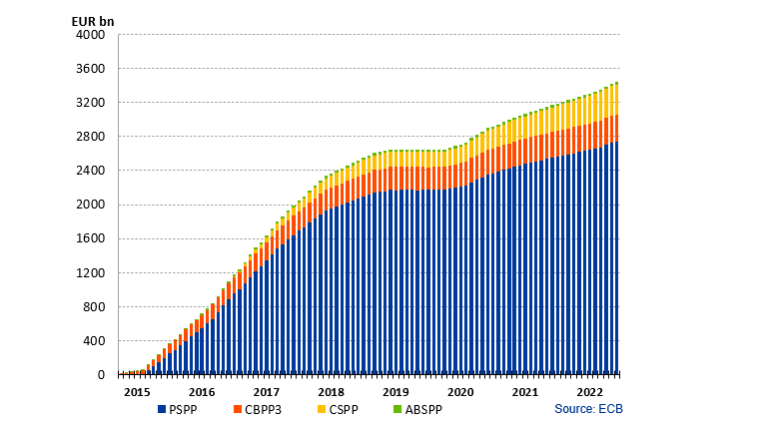The collapsing euro and its implications
by Alasdair Macleod, GoldMoney:

The euro system and its currency are descending into crisis. Comprised of the ECB and the National Central Banks, the system is over its head in balance sheet debt, and it is far from clear how that can be resolved.
Normally, a central bank is easy to recapitalise. But in the case of the euro system, when the lead institution and all its shareholders need to be recapitalised all at the same time the challenge could be impossible. And then there’s all the imbalances in the TARGET2 system to resolve as well before national legislatures can sign it all off. Additionally, but part of the TARGET2 problem there’s the repo market with €8.7 trillion outstanding, set to implode on rising interest rates, destroying commercial bank balance sheets which are already highly leveraged.
TRUTH LIVES on at https://sgtreport.tv/
This goes some way to explaining the deep reluctance the ECB has about raising interest rates. While producer prices in key member states are rising at over 30% year-on-year, and consumer prices by over 8%, the ECB keeps its deposit rate at minus 0.5%. It knows that if euro bond yields go any higher their situation which is already untenable will disintegrate into a full-blown crisis.
Therefore, the euro is sliding. Markets can see that all the ECB is doing is talking the talk and otherwise is frozen into inaction.
Fiddling while Rome burns…

At a political level there appear to be terrifying levels of ignorance about the economic consequences of continuing to punish Britain for Brexit (yes, that still rankles) and now ostracising Russia for its belligerence at a time when the EU’s own economy is teetering on the edge of a financial and economic catastrophe. The EU exercises its political agendas despite any economic mayhem created.
Russia is a far more serious issue than Brexit ever was. The EU has, to varying degrees, disposed of its fossil fuel capacity to placate environmentalists, exporting their production to nations not so squeamish about fashionable climate change strictures. Consequently, the EU has become highly dependent on Russian natural gas and oil, which in cavalier fashion it has decided to do without to punish Russia over its invasion of Ukraine.
The economic consequences have been to put Germany’s economy on life support with its industrial limbs beginning to shut down, along with the productive capacity of many other EU states. In the coming months there will be food shortages exacerbated by lack of fertiliser supplies. Then there will be winter without heating fuel and frequent power cuts. And winter with food shortages in a continental climate is no joke. They will spark riots and growing political instability.
The financial consequences stem partly from bank exposure to Russian entities, but far more important is the effect of soaring producer and consumer prices on the entire Eurozone financial structure. The euro system has depended on redistributing wealth from Germany and the fiscally conservative northern states to bail out the profligate south using suppressed interest rates. That scheme is now kaput.
The ECB, and the euro system of shareholder national central banks, has metaphorically been caught with their collective trousers down. Having suppressed interest rates into negative territory, they allowed member governments to borrow ultra-cheaply. Now that Eurozone CPI is rising at 8.6% and Germany’s producer prices are up 33.6%, either interest rates must rise smartly or the euro crashes. Our headline chart of the euro/dollar rate at the top of this article refers to the market’s reaction so far.
Bonds in the ECB’s Asset Purchase Programme have accumulated as shown in the chart below, split out into the Public Sector Purchase Programme (PSPP), Corporate Sector Purchase Programme (CSPP), Asset-backed Securities Purchase Programme (ABSPP) and the Third Covered Bond Purchase Programme (CBPP3). In June, they totalled €3,265,172 million.

From a year ago, government bonds have risen in yield from minus 0.5% to 1.36% for Germany’s 10-year bond, an overall rise of 1.86%. The rise in yield for a similar Italian bond is 2.87%, Spain’s 2.3%, France’s 2%, and Greece’s 3.2%. Given that government stock is 65% of the total, the rest being generally higher yielding corporate bonds, a conservative estimate is that if the portfolio has an average maturity of ten years the mark-to-market loss from a year ago is already in the region of €750bn. This is almost seven times the combined euro system balance sheet equity and reserves of €109.272bn. And as yields rise further, euro system losses of double that are easy to imagine.
Doubtless, if challenged the ECB would claim the euro system will hold these bonds to maturity, so they will continue to value them at par. But the euro system is unlikely to cease funding member states by inflationary means. And we cannot ignore the likelihood of further rises in yield due to the disparity between current interest rates (the ECB’s deposit rate is minus 0.5%) and a CPI heading towards annual increases of 10%.
The monetary error behind the EU concept
The concept underlying the EU can be summed up as the socialising of the wealth of the northern states to subsidise the southern and less wealthy member nations. In keeping with its post-war low political profile, Germany went along with the European project’s evolution from being a trading bloc into a currency union.
The euro was intended to be a leveller, enabling nations like Italy, Spain and Greece to piggyback on Germany’s debt rating, on the statist argument that being issued by a sovereign nation tied into a common currency and settlement system, there is little difference between owning German and Italian, or even Greek sovereign debt. The consequences were that through investing institutions Germany’s savers directly and indirectly subsidised debt issued at levels that fail to compensate for the borrower’s true risk. The FRED chart below shows the effect on otherwise risky Italian 10-year benchmark bond yields.

In the run up to the replacement of national currencies by the euro, the Maastricht rules for qualification were ignored. Otherwise, Italy’s level of sovereign debt would have disqualified its entry. The market rate for Italy’s 10-year government bond was a yield of 12.4% when the Maastricht treaty setting the conditions for entry into monetary union came into effect in 1992. Germany’s equivalent benchmark yielded 8.3% for a differential of 4.1%. Today the German benchmark yields 1.35% and the Italian 3.37%, a difference of 2.2%. Not only has the gap converged, but by the end of 2021 the quantity of Italian government debt had increased to over 150% of GDP.
Similar examples can be shown of the other PIGS — Portugal, Greece, and Spain. Clearly, the evidence is that markets are not pricing sovereign risk as they should, and their yields are being heavily suppressed. Stuck in debt traps, even more debt needs to be issued because the outlook for budget deficits in these nations is simply dire, made worse by a Eurozone economy on the verge of an energy induced meltdown.
The ECB and its impossible task
So far, we have laid bare the consequences of the energy crisis for the eurozone economy and the losses that arise on the euro system balance sheets. Overseeing it all is the ECB’s president, who previously served as Chair of the IMF and before that held roles in the French government, including economy and finance minister. With this experience she was appointed to the ECB as a safe pair of hands. And as such, she has inherited an impossible position, because she has no mandate to moderate the ECB’s inflationary policies.
More correctly, Lagarde inherited two impossibilities. The first is to continue to distribute Germany’s national wealth to support the PIGS, and the second is a banking system that is well and truly broken. And as stated earlier, Germany itself is now on life support.
Table A shows the relationship between the Eurozone G-SIBs’ balance sheet totals, their balance sheet equity, and market capitalisations to illustrate the fragility of the Eurozone’s global systemically important banks (G-SIBs).

G-SIBs are required to have extra capital buffers designed to ensure they do not create or spread counterparty risk. The liquidity is created from the structure of the total balance sheet and does not require shareholders’ capital to be involved. Nevertheless, gearing between total assets and balance sheet equity (which includes undistributed profits and ranking capital other than common shares) average just over twenty times for the Eurozone G-SIBs, ranging from Credit Agricole at 27 times to Unicredit at 14.8 times.
Price to book values for all these banks are at a discount, some deep enough to call their immediate survival into question, given that an economic downturn for the Eurozone is now in progress. If they are to protect their shareholders’ equity, these banks have no alternative but to contract their balance sheets where they can. Indeed, when it occurs, a downturn in GDP is due in large measure to the withdrawal of bank credit. This is bound to expose and create bad debts, which threatens to wipe out shareholders’ capital entirely.
Read More @ GoldMoney.com
[ad_2]
Source link

